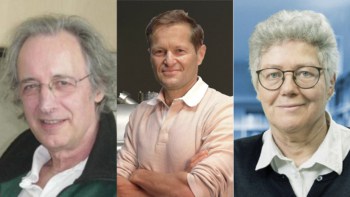
A new method for using light to cool solids has been created by physicists in France and Germany. The technique uses quasiparticles called “polaritons” to remove vibrational heat from a tiny piece of semiconductor, and unlike previous optical cooling schemes it works at very low temperatures. The scheme could provide a new way of cooling very small electronic devices, as well as giving physicists an alternative approach to studying heat transport.
Developed by Maxime Richard of the University of Grenoble and colleagues, the new cooling technique is based on “anti-Stokes fluorescence” (ASF), which has already been used with limited success to cool solids. In the case of a semiconductor, this involves laser light being used to create an electron–hole pair, or “exciton”, in the material, which can then absorb one or more thermal vibrations (phonons). The exciton will go on to decay into a photon that carries with it the thermal energy.
Physicists have been able to use ASF to cool a semiconductor from room temperature to 260 K – a difference of about 30 K. Achieving more cooling power is difficult because defects in the semiconductor cause some excitons to decay and return heat to the material via multiple phonons. Some of the laser light therefore heats the material, rather than cooling it.
Polariton sandwich
The new variant of ASF gets round this problem by not using excitons but polaritons, which form when photons interact strongly with excitons. The technique involves confining the polaritons within a semiconductor microcavity, which is essentially a semiconductor material sandwiched between two semi-transparent mirrors. This confinement imposes a non-zero minimum energy on the polariton, which means that it cannot decay via phonons alone.
Another important benefit of the scheme is that polaritons interact strongly with thermal phonons and polaritons are able to absorb phonons over a wide range of energies. This includes very low energies, which means that the technique should work at very low temperatures.
While the researchers admit that building a practical cooling system based on polaritons would be a technological challenge, they have made preliminary measurements that suggest the technique should work in principle. Their experiment involves firing a laser into the microcavity through one of the mirrors. Polaritons are formed in the semiconductor as the photons bounce back and forth.
Fast and slow cooling
The polariton can then undergo one of two cooling interactions with phonons. “Fast cooling” involves the absorption of one phonon followed by the emission of an ASF photon and is so-called because it happens in about 1 ps. The “slow cooling” interaction takes about 200 ps and begins with absorption of a phonon, then the emission of a lower-energy phonon and finally an ASF photon. Although some heat is returned to the semiconductor during slow cooling, the net cooling effect is actually greater than with fast cooling.
The team confirmed the existence of these processes by detecting the ASF photons that are emitted from the cavity and thus the amount of heat that is being removed from the system. The measurements were obtained over a range of laser intensities and temperatures, allowing the researchers to identify regions in this parameter space where the cooling power is greatest. The results show that big cooling powers can be achieved at temperatures down to at least 4.2 K, which is the lowest tested.
Richard told physicsworld.com that the team is now planning to use the latest nano-fabrication techniques to build a “polariton refrigerator” that measures several tens of microns across and should be able to cool tiny objects. He also points out that “polaritons are a model system of a highly non-equilbrium gas”, and so the team plans to use the system to study how its non-equilibrium properties affect the transport of heat.
The study is described in Physical Review Letters.



